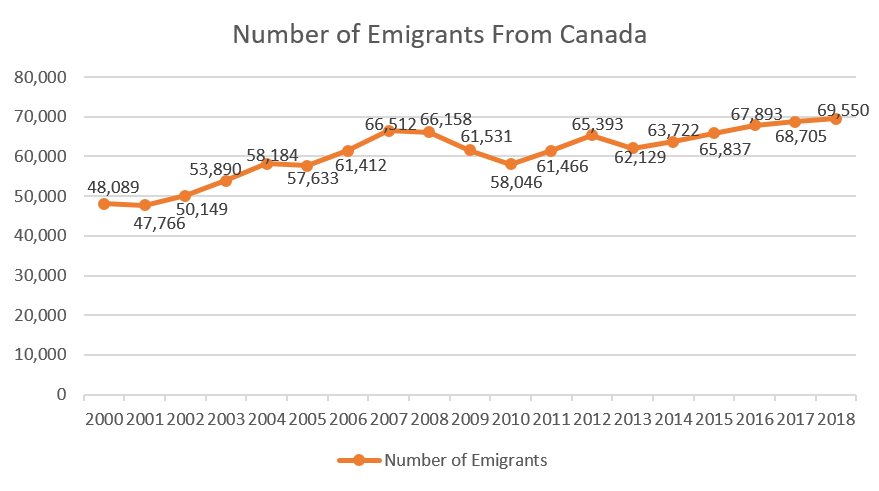Important: The GCConnex decommission will not affect GCCollab or GCWiki. Thank you and happy collaborating!
Difference between revisions of "Immigration, Emigration and Retention (Under Development)"
(Created page with "fr:Émissions de gaz à effet de serre (GES) et énergie {{CGG E|border=#197446|1=linked|2=focus|3=linked|4=linked|5=linked|6=linked|7=linked|8=linked|9=linked|10=linked|...") |
|||
| Line 3: | Line 3: | ||
{{CGG E|border=#197446|1=linked|2=focus|3=linked|4=linked|5=linked|6=linked|7=linked|8=linked|9=linked|10=linked|11=linked|12=}} | {{CGG E|border=#197446|1=linked|2=focus|3=linked|4=linked|5=linked|6=linked|7=linked|8=linked|9=linked|10=linked|11=linked|12=}} | ||
| − | + | [[File:Number of Emigrants from Canada.png|right|frameless]] | |
| − | [[File: | + | •Emigration: Permanent emigration refers to Canadian citizens or landed immigrants who leave Canada to acquire permanent residency in another country, while temporary emigration refers to Canadian citizens and immigrants living temporarily abroad who have not maintained a usual place of residence in Canada |
| − | |||
| − | The | + | •Outmigration: The action of leaving one place to settle in another, especially within a country. |
| − | + | •Based on Canadian Censuses the net exit rate of emigration for the naturalized portion of the Canadian population for the 1996-2006 period is 4.5%. | |
| + | |||
| + | •A similar census-based estimate for the Canadian-born population yields a low net exit rate for the 1996-2006 period (1.33%) which translates into 500,000 Canadian-born leavers over the 1996-2006 period. | ||
| + | |||
| + | •Over the period 1996-2006 the naturalized group exhibited a three times greater emigration rate than the Canadian-born population. | ||
| + | |||
| + | •Moreover, given these exit rates for both the Canadian and foreign-born populations, a stock of 2.78 million Canadian leavers living abroad can be estimated. | ||
| + | |||
| + | •Canada has experienced a unique problem as a subset of its immigrants, approximately 10%, leave after ascension to citizenship. | ||
| + | |||
| + | •Most Canadians abroad feel strongly “Canadian” and strongly desire to remain connected to Canada. | ||
| + | |||
| + | •As of 2016, about 783,000 Canadians lived in the United States, accounting for less than 2 percent of the roughly 44 million U.S. immigrants A quarter of the CND diaspora in the US is significant | ||
Revision as of 12:09, 21 November 2019
•Emigration: Permanent emigration refers to Canadian citizens or landed immigrants who leave Canada to acquire permanent residency in another country, while temporary emigration refers to Canadian citizens and immigrants living temporarily abroad who have not maintained a usual place of residence in Canada
•Outmigration: The action of leaving one place to settle in another, especially within a country.
•Based on Canadian Censuses the net exit rate of emigration for the naturalized portion of the Canadian population for the 1996-2006 period is 4.5%.
•A similar census-based estimate for the Canadian-born population yields a low net exit rate for the 1996-2006 period (1.33%) which translates into 500,000 Canadian-born leavers over the 1996-2006 period.
•Over the period 1996-2006 the naturalized group exhibited a three times greater emigration rate than the Canadian-born population.
•Moreover, given these exit rates for both the Canadian and foreign-born populations, a stock of 2.78 million Canadian leavers living abroad can be estimated.
•Canada has experienced a unique problem as a subset of its immigrants, approximately 10%, leave after ascension to citizenship.
•Most Canadians abroad feel strongly “Canadian” and strongly desire to remain connected to Canada.
•As of 2016, about 783,000 Canadians lived in the United States, accounting for less than 2 percent of the roughly 44 million U.S. immigrants A quarter of the CND diaspora in the US is significant

